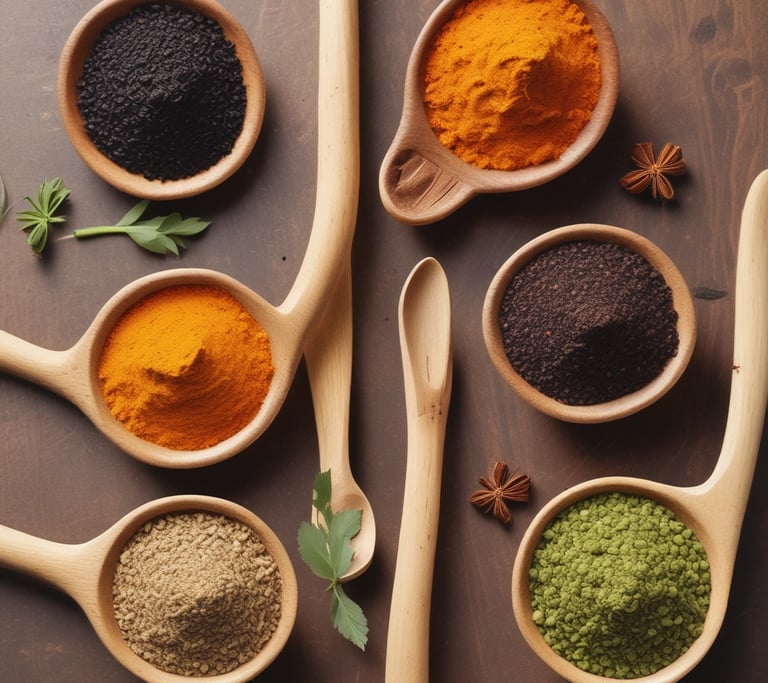A Beginner's Guide to Indian Spices | Unlock the Secrets of Flavor
Learn about essential Indian spices, how to use them, and discover top spice blends like garam masala, cumin, turmeric, and coriander in this beginner's guide to Indian cooking.
INDIAN CUISINE
4/16/20253 دقيقة قراءة


A Beginner's Guide to Indian Spices: Unlocking the Secrets of Flavor
Indian cuisine is renowned worldwide for its rich, vibrant flavors, and at the heart of these delicious dishes are the spices that give them their signature taste. Whether it's the warmth of cumin, the earthy tones of turmeric, or the aromatic depth of garam masala, spices are not just ingredients—they are the soul of Indian cooking.
In this guide, we will take a deep dive into the world of Indian spices and explore how these powerful ingredients can transform your cooking. If you're new to Indian cooking or looking to expand your culinary horizons, learning how to use spices is essential to unlocking the full potential of Indian cuisine.
What Are Indian Spices?
Indian spices are known for their ability to balance taste, aroma, and health benefits in every dish. Spices are used in different forms: whole, ground, or toasted, and they are combined in unique ways to create complex flavor profiles. The use of spices is not only about adding flavor but also about creating an experience for the senses.
Some of the most commonly used spices in Indian kitchens include:
Turmeric: Often referred to as "Indian gold," turmeric has a slightly bitter taste and is known for its vibrant yellow color. It’s a key ingredient in curries, and it also boasts numerous health benefits.
Cumin: With its warm, nutty flavor, cumin is a must-have in every Indian spice box. It is used both whole and ground and is perfect for adding depth to curries, soups, and rice dishes.
Coriander: Coriander seeds have a mild, citrusy flavor that adds a refreshing note to any dish. It’s commonly used in both sweet and savory preparations.
Mustard seeds: These tiny, round seeds pop when heated in oil and add a delightful tangy flavor to dishes. They are often used in tempering to infuse the oil with their unique taste.
The Role of Garam Masala in Indian Cooking
One spice blend that is a cornerstone of Indian cooking is garam masala. This aromatic mixture is made up of several spices such as cardamom, cinnamon, cloves, cumin, and coriander. Garam masala is used in almost every Indian dish, whether it's a curry, stew, or rice dish. The unique combination of these spices adds warmth, complexity, and a hint of sweetness to any dish.
Garam masala is often added at the end of the cooking process, just before serving, to preserve its aromatic quality. It is also used as a garnish or sprinkled on top of dishes for added flavor.
How to Use Indian Spices in Your Cooking
Learning how to use Indian spices effectively can elevate any dish. Here are some key tips to get started:
Toast Whole Spices: Before grinding or adding them to your dish, toast whole spices like cumin, mustard seeds, and coriander seeds in a dry pan. This enhances their flavor and releases their essential oils.
Balance Heat and Flavor: Indian dishes often contain both spicy and mild flavors. Adjust the level of heat by adding chilies or chili powder to your liking. Always balance it with other spices to prevent the dish from becoming too hot.
Use Fresh Spices: For the best flavor, try to use fresh spices. Ground spices lose their potency over time, so it's always better to grind whole spices yourself.
Create Spice Blends: Create your own spice blends based on your taste preferences. A basic curry powder can be the perfect blend of cumin, coriander, and turmeric, but feel free to get creative with your mixtures.
Top 5 Essential Indian Spices Every Cook Should Have
Here are the top 5 Indian spices you absolutely need to start with:
Turmeric: A vibrant yellow spice with earthy, bitter undertones.
Cumin: Warm and nutty, essential in Indian curries.
Coriander: Bright and citrusy, perfect for refreshing salads and rice dishes.
Ginger: Adds a zesty, fresh kick to both savory and sweet dishes.
Chili Powder: For adding heat and depth to your curries and stews.
👉 Explore More: 15+ Authentic Indian Spices and Recipes
Ready to take your spice game to the next level? Our digital guide to Indian spices offers you 15+ authentic recipes that will help you master the use of spices in your cooking. From spicy curries to flavorful rice dishes, this guide provides step-by-step instructions on how to incorporate these ingredients into your meals. Unlock the secrets of Indian spices and start creating mouthwatering dishes today. [Get Your Guide Now]
Final Thoughts: Spice Up Your Life with Indian Flavors
Indian spices are the secret to creating complex, aromatic, and mouthwatering dishes. Whether you’re making a rich curry or a simple rice dish, learning how to use spices effectively can elevate your cooking and take your meals to new heights.
If you’re new to cooking with spices, start with the basics, and then explore deeper with our guide to 15+ authentic Indian recipes. Soon, you'll be creating dishes that are full of flavor and authenticity, right from the comfort of your home.
Explore
Connect
© 2025. All rights reserved.
